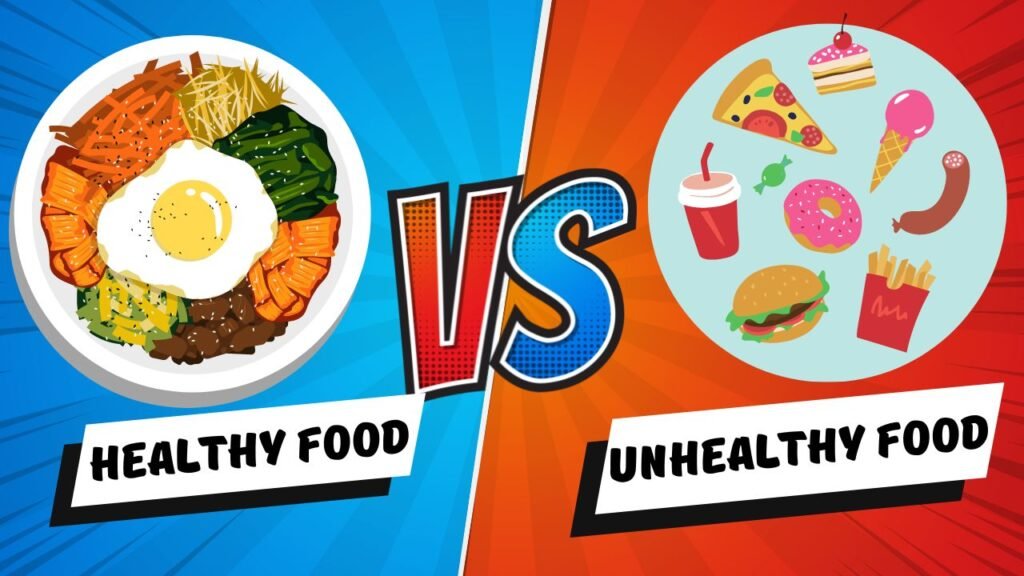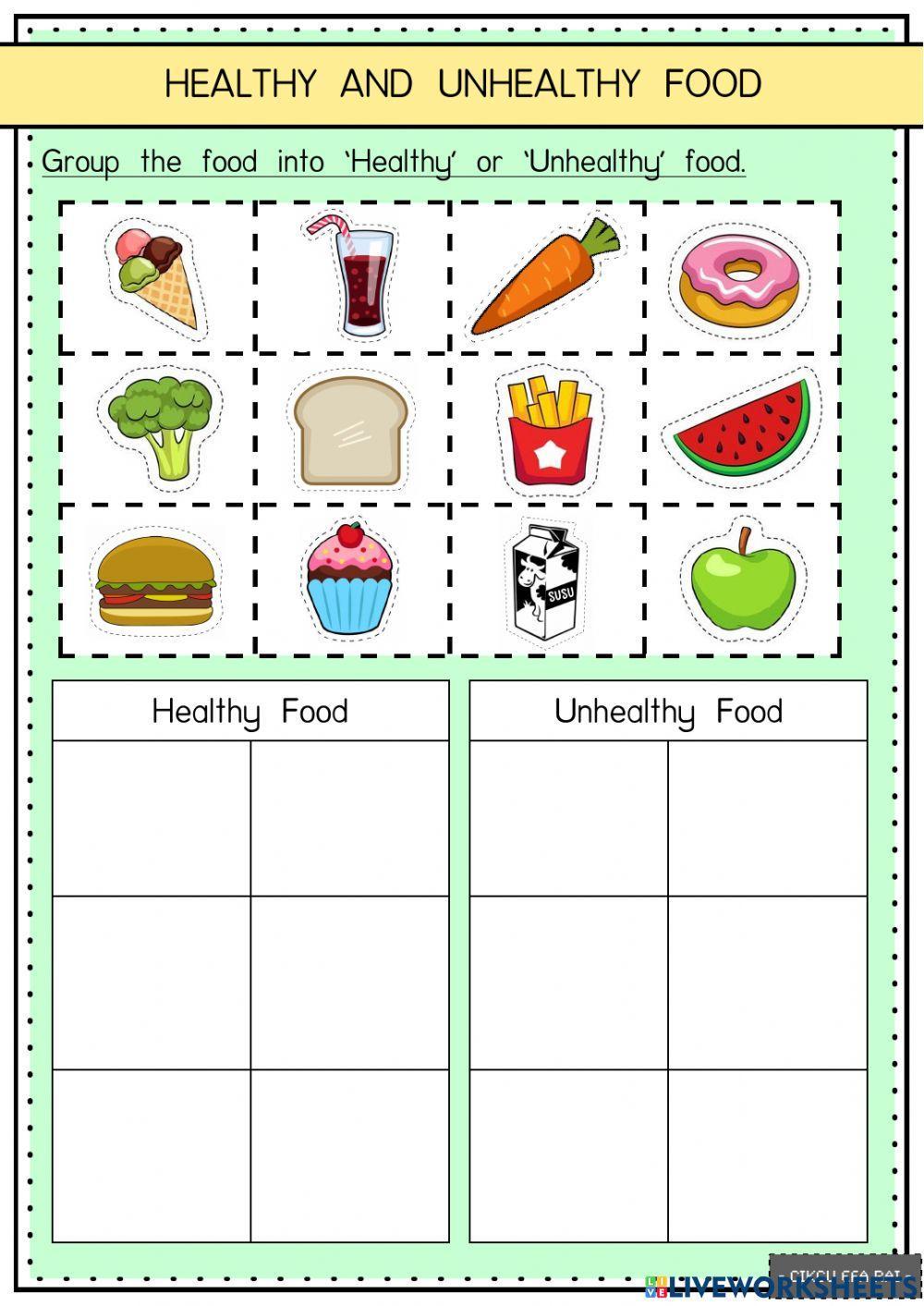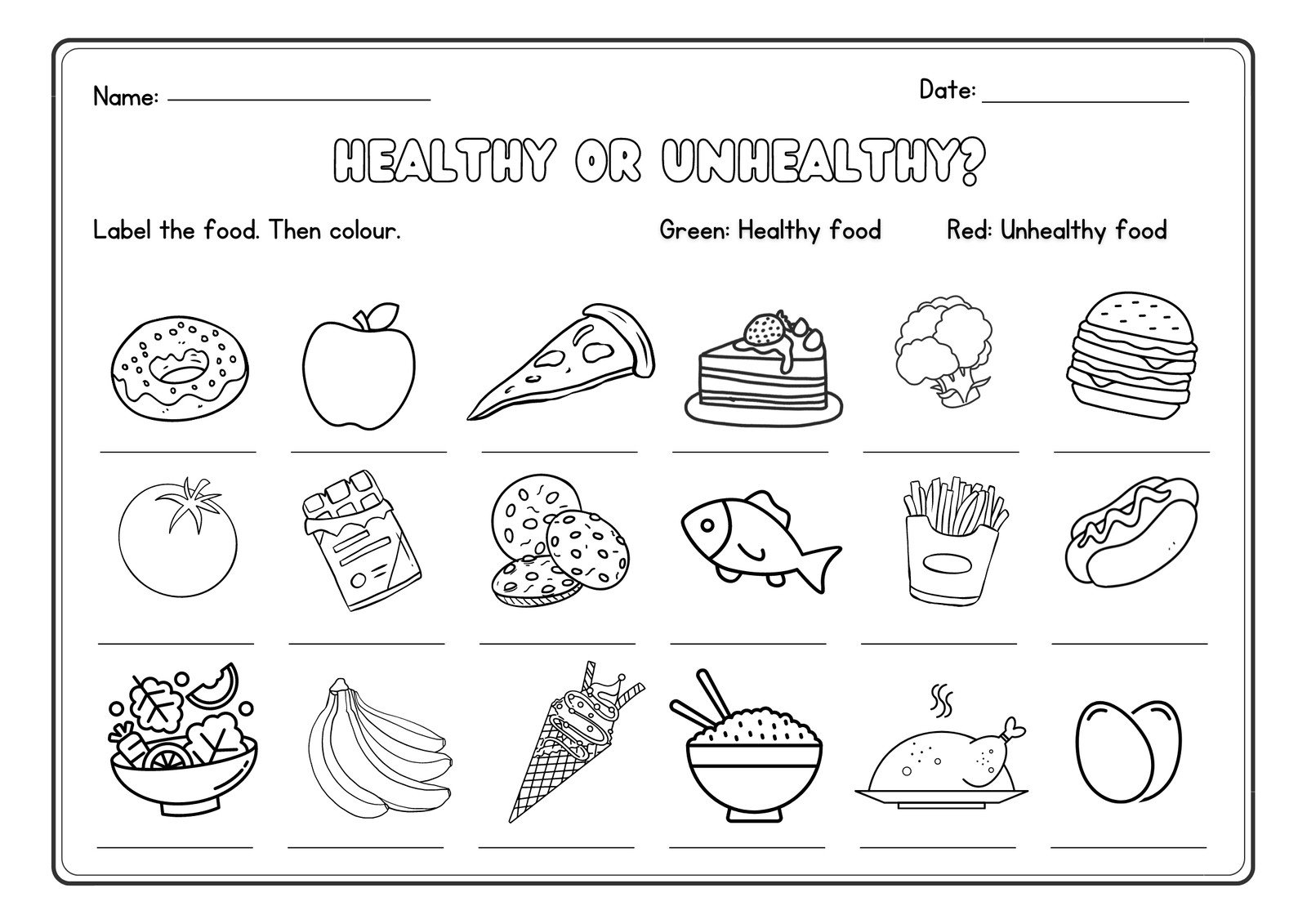
Healthy and Unhealthy Food Worksheet helps children distinguish between nutritious foods like fruits and vegetables and unhealthy options like chips and fried meat. This activity aids in promoting healthy eating habits from an early age.
It is crucial to educate children about the importance of making smart food choices to maintain good health and well-being. By engaging in this worksheet, kids can learn to identify and categorize various food items based on their nutritional value.
This not only enhances their understanding of healthy and unhealthy foods but also encourages them to make better dietary decisions. Developing these habits early can have a significant impact on their overall health and lifestyle in the future. This worksheet serves as an effective tool for instilling the value of proper nutrition in children, setting them on a path toward a healthier and balanced diet.
Identification
Healthy foods like fresh fruits, green leafy vegetables, and raw nuts are excellent sources of energy and essential nutrients.
Unhealthy foods such as fried chips, burgers, and pizza are typically high in fat content and provide low nutritional value.
Benefits Of Healthy Foods
Discover the numerous benefits of incorporating healthy foods into your diet with our Healthy And Unhealthy Food Worksheet. This printable resource allows you to sort and differentiate between nutritious options and those that may negatively impact your health. Start your journey towards a healthier lifestyle today.
Healthy foods play a crucial role in maintaining overall well-being and vitality. These nutrient-rich options provide a wide array of advantages that are essential to our daily lives. Let’s delve deeper into some of the key benefits of consuming healthy foods.
Boosting Immune System
Eating a balanced diet comprising fruits, vegetables, and lean proteins enhances the immune system’s functionality, making it more efficient in warding off illnesses and infections.
Maintaining Weight Balance
Healthy foods are instrumental in regulating body weight and promoting an optimal body mass index (BMI). The consumption of nutritious choices helps in preventing obesity and related health issues.
Sustaining Energy Levels
By incorporating healthy foods into your diet, you can ensure a sustained and consistent supply of energy. Nutrient-dense foods keep fatigue at bay and aid in maintaining optimum energy levels throughout the day.
Incorporating these benefits into our dietary habits not only ensures physical well-being but also contributes to holistic health and vitality.
Risks Of Unhealthy Foods
Consuming unhealthy foods presents various risks, including obesity, heart disease, and diabetes. These foods often contain high levels of sugar, saturated fats, and empty calories, leading to long-term health problems. It’s important to promote awareness of the detrimental effects of unhealthy food choices through educational resources like worksheets.
## Risks of Unhealthy Foods
### Weight Gain
Unhealthy foods are known to contribute to weight gain. These foods are often high in calories, sugars, and unhealthy fats, leading to an imbalance in our body’s energy intake. Consuming too many unhealthy foods can cause excess weight gain, increasing the risk of obesity and related health issues.
### Health Complications
Unhealthy foods can lead to various health complications. They are often low in essential nutrients such as vitamins, minerals, and fiber, while being high in unhealthy additives and preservatives. This lack of nutrition can result in deficiencies, weakened immune system, and an increased risk of developing chronic diseases such as heart disease, diabetes, and certain types of cancer.
### Reduced Lifespan
Consistently consuming unhealthy foods can have a negative impact on our lifespan. These foods are often processed, fried, or high in refined sugars, which can lead to inflammation and oxidative stress in our bodies. Over time, this chronic inflammation and stress can contribute to accelerated aging, decreased vitality, and an overall reduced lifespan.
It is important to be mindful of the risks associated with unhealthy foods and make conscious choices towards a healthier diet. By opting for nutrient-rich, whole foods and minimizing the consumption of processed, sugary, and fried foods, we can promote better overall health and well-being.

Credit: www.liveworksheets.com
Differentiating Factors
When it comes to differentiating between healthy and unhealthy foods, there are several crucial factors to consider that can greatly impact our overall well-being. Understanding these factors is essential for making informed choices about what we consume on a daily basis. Let’s delve into the key differentiating factors that can help us distinguish between the two.
Energy Levels
Healthy foods like fresh fruits, green leafy vegetables, sprouts, raw nuts, and yogurt are rich in essential nutrients and provide a sustained release of energy throughout the day. On the contrary, unhealthy foods such as fried chips, burgers, pizza, and fried meat are low in energy and high in fat content, leading to a temporary energy surge followed by a crash.
Nutrient Content
Healthy foods are packed with essential nutrients such as vitamins, minerals, fiber, and antioxidants that are vital for our body’s growth, repair, and overall function. In contrast, unhealthy foods often lack these vital nutrients and are typically high in unhealthy fats, sugars, and artificial additives that can have detrimental effects on our health.
Impact On Health
Consuming a diet rich in healthy foods has numerous benefits, including improved immune function, maintained weight balance, sustained energy levels, and overall better physical, mental, and emotional health. Unhealthy foods, on the other hand, can lead to weight gain, adverse health conditions, and a reduced lifespan due to the negative impact on our wellbeing.
Achieving Balance
Enhancing wellness means finding a balance between healthy and unhealthy food choices. Engage with a Healthy And Unhealthy Food Worksheet to differentiate and educate on nutritious eating habits.
Building A Balanced Diet
Moderation In Indulgence
Achieving balance in our diets is essential for maintaining optimal health and well-being. It’s important to strike a harmonious blend of healthy and unhealthy food choices to create a balanced diet. By incorporating nutritious foods while allowing ourselves occasional indulgences, we can enjoy the benefits of a healthy lifestyle without feeling deprived or restricted.
Building A Balanced Diet
A balanced diet consists of a variety of nutrients that our bodies need to function properly. This includes carbohydrates, proteins, fats, vitamins, minerals, and water. To achieve balance, it’s crucial to include a combination of healthy foods from each food group.
A healthy meal plan should include:
- Whole grains, such as brown rice and whole wheat bread, which provide fiber and essential nutrients.
- Lean proteins, like chicken, fish, beans, and tofu, which supply amino acids for cell repair and growth.
- Fruits and vegetables, which are rich in vitamins, minerals, and antioxidants that boost immunity.
- Healthy fats, such as those found in avocados, nuts, and olive oil, which support heart health.
- Dairy or dairy alternatives, like milk, yogurt, or soy products, which are a good source of calcium and vitamin D.
Achieving balance also means being mindful of portion sizes. It’s important to eat reasonable amounts of each food group to prevent overconsumption and maintain a healthy weight.
Moderation In Indulgence
While it’s crucial to prioritize healthy food choices, it’s also important to indulge occasionally. Including some of your favorite treats in moderation can help satisfy cravings and prevent feelings of deprivation.
However, moderation is the key. Indulging too frequently or excessively in unhealthy foods can have negative effects on our health. These foods are typically high in sugar, unhealthy fats, and additives, which can increase the risk of chronic diseases like obesity, diabetes, and heart disease.
To strike a balance, consider the 80/20 rule. Aim for 80% of your diet to consist of nutritious, whole foods and reserve the remaining 20% for occasional indulgences. This approach allows for flexibility and enjoyment while maintaining a healthy eating pattern.
By building a balanced diet and practicing moderation in indulgence, we can achieve and maintain a healthy relationship with food. Remember, it’s all about finding the right balance that works for you and your individual needs.

Credit: www.pinterest.com
Educating Children
Teaching children the importance of healthy eating is crucial for their overall wellbeing. Through interactive worksheets and engaging activities, they can develop a strong foundation for making nutritious food choices.
Teaching Healthy Food Choices
Introducing different food groups can help children understand the benefits of each. Encourage them to identify healthy options like fruits, vegetables, and whole grains.
Engaging Activities For Kids
- Cooking Classes: Involve children in preparing simple, nutritious meals.
- Food Sorting Games: Teach them to categorize foods into healthy and unhealthy groups.
- Role-Playing: Act out scenarios where they make healthy food choices.
- Coloring Worksheets: Use fun coloring sheets with healthy food items.
Practical Applications
Practical Applications: When it comes to educating children on healthy eating habits, a Healthy and Unhealthy Food Worksheet can be a valuable tool. These worksheets offer practical ways for kids to differentiate between nutritious foods and those that are less beneficial.
Using Worksheets For Sorting Foods
Interactive worksheets can help children categorize various foods based on their nutritional value. By engaging in activities such as sorting fruits and vegetables into “healthy” and “unhealthy” categories, kids develop a better understanding of the importance of making nutritious food choices.
Interactive Learning Resources
Utilizing interactive resources alongside worksheets can enhance children’s learning experience. Online platforms offer engaging games, quizzes, and visual aids that make learning about healthy and unhealthy foods fun and informative.

Credit: www.canva.com
Frequently Asked Questions
What Are Examples Of Healthy And Unhealthy Foods?
Healthy foods include fresh fruits, green leafy veggies, sprouts, nuts, and yogurt. Unhealthy options are fried chips, burgers, pizza, and fried meat.
What Are Healthy And Unhealthy Foods In A Small Paragraph?
Healthy foods include fresh fruits, vegetables, sprouts, nuts, and yogurt, providing energy and supporting overall health. Unhealthy foods like fried chips, burgers, and pizza are high in fat and can lead to weight gain and health issues. Maintaining a balanced diet is crucial for overall well-being.
How Do You Balance Healthy And Unhealthy Foods?
To balance healthy and unhealthy foods, focus on incorporating more fruits, vegetables, nuts, and yogurt while limiting fried, high-fat items like chips and burgers.
How Do You Teach Healthy And Unhealthy Food?
To teach healthy and unhealthy food, use interactive worksheets for sorting, matching, and naming food items. These worksheets help children differentiate between nutritious and unhealthy options. Show examples of fruits, vegetables, and nuts as healthy choices, while fried chips and burgers represent unhealthy options.
Encourage discussions on the benefits of healthy food for overall well-being.
Conclusion
In understanding the importance of healthy and unhealthy foods, it’s clear that the choices we make have a significant impact on our overall well-being. By identifying and distinguishing between these food types, individuals can make informed decisions that positively influence their physical and mental health.
With the knowledge gained from this worksheet, individuals can strive towards a balanced and nutritious diet for a healthier lifestyle.

I am a blogger for holistic wellness & longevity. With a passion for nutrition, fitness, & mindfulness, I’m dedicated to sharing insights on healthy living. Join my journey towards a vibrant life with practical tips & evidence-based advice. Embrace vitality and thrive with me!

